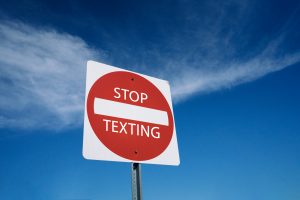 Texting is arguably more dangerous than drunk driving. According to a study conducted by Car And Driver, a driver’s reaction time is worse while texting than while intoxicated. With nearly all drivers in possession of a cell phone, it seems likely many more people are driving while texting than driving while under the influence of alcohol or drugs. For decades, law enforcement has developed methods to detect drunk driving. Officers now need a way to detect texting while driving without violating individuals’ right to privacy. Is the new “Textalyzer” the answer?
Texting is arguably more dangerous than drunk driving. According to a study conducted by Car And Driver, a driver’s reaction time is worse while texting than while intoxicated. With nearly all drivers in possession of a cell phone, it seems likely many more people are driving while texting than driving while under the influence of alcohol or drugs. For decades, law enforcement has developed methods to detect drunk driving. Officers now need a way to detect texting while driving without violating individuals’ right to privacy. Is the new “Textalyzer” the answer?
Texting Laws And The Textalyzer
Nearly all states, including Ohio, now have laws prohibiting texting while driving. The state-wide ban in Ohio Revised Code section 4511.204 prohibits operating a motor vehicle ‘while using a handheld electronic communications device to write, send, or read a text-based communication’. Another Ohio law, Revised Code section 4511.991, enhances the sentence of a traffic violation if distracted driving is a contributing factor to the commission of the offense. The problem is not prohibiting the conduct with a law: the problem is enforcing the law which prohibits the conduct. To address the difficulty of enforcing these laws, several states are considering laws which permit the use of a device like the Textalyzer.
The manufacturer of the Textalyzer, Cellebrite, says the device will help law enforcement officers prove whether a driver was using a mobile phone while driving. Officers would plug the device into the driver’s cell phone and scan the phone for recent activity. The device would tell officers when the phone was used for activities such as texting, Facebook messaging, and web browsing. Because the device can reportedly time-stamp the cell phone activity, officers would be able to determine whether the cell phone use was a factor in an accident or traffic violation.
Potential Practical And Legal Problems With The Textalyzer
The apparent practical problem with the device is its ability to distinguish between hand-held use and hands-free use of a cell phone. This is important in Ohio, as our laws only prohibit hand-held use, and the sentence enhancement specifically excludes using a phone with a ‘voice-operated or hands free’ device. Cellebrite claims the Textalyzer would be able to determine whether an app was being used in hands-free mode, but critics say the device has not been tested in real-world settings.
The legal problem the Textalyzer is its use could violate a driver’s right to be free from unreasonable searches and seizures. A person has a reasonable expectation of privacy in the information contained in the person’s cell phone. Using the Textaxilyzer to examine a cell phone is a search. The Textalyzer is designed to be used by officers at the scene of a traffic offense, so the search would presumably be without a warrant. A search without a warrant is presumed to be unreasonable. That’s why the United States Supreme Court held in Riley v. California search warrants are required for law enforcement to search cell phones.
Searching a cell phone is similar to performing a blood test in a DUI / OVI case. The U.S. Supreme Court has concluded that such a blood test requires a search warrant unless there is a recognized exception to the warrant requirement, like exigent circumstances. The Court, in Missouri v. McNeely, stated in the dissipation of alcohol in DUI cases does not necessarily provide exigent circumstances which obviate the need for a search warrant.
In cases involving texting while driving, there are generally not exigent circumstances. Officers typically have the opportunity to obtain a search warrant before examining the contents of a cell phone. That means use of the Textalyzer will typically require a search warrant. It is doubtful whether officers and judges will be in favor of issuing search warrants in these types of cases. We need an antidote for the plague of distracted driving, but the Textalyzer may not be the best remedy.
 Columbus OVI/DUI Attorney Blog
Columbus OVI/DUI Attorney Blog

